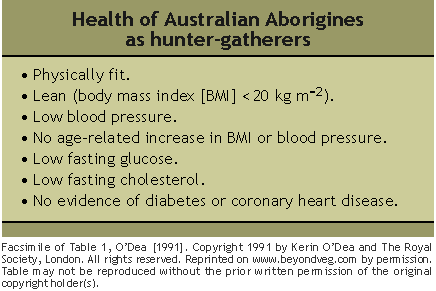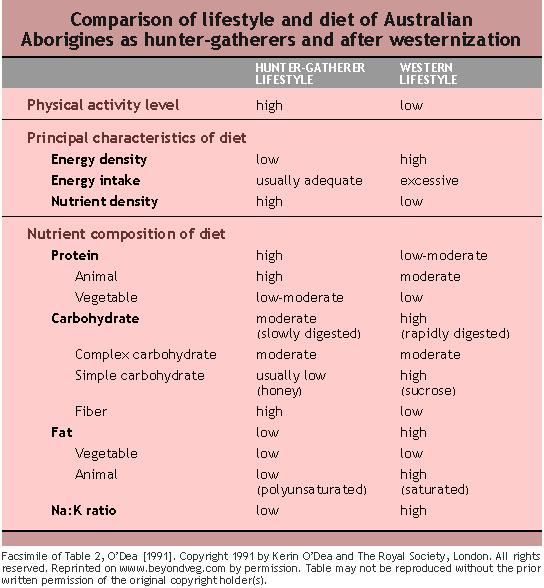![]()

|
|
 |
| Hunter-Gatherers: Examples of Healthy Omnivores |
HEALTH AND DISEASE IN HUNTER-GATHERERS
![]()
Dunn also notes
7. Ample evidence is available that "social mortality" has been and is significant in the population equation for any hunting and gathering society.
4. Accidental and traumatic death rates vary greatly among hunter-
In the above, social mortality refers to warfare, cannibalism, sacrifice, infanticide, etc. These are rare or non-
8. Parasitic and infectious disease rates of prevalence and incidence are related to ecosystem diversity and complexity. Although many of these diseases contribute substantially to mortality, no simple, single generalization is possible for all hunter-
3. Chronic diseases, especially those associated with old age, are relatively infrequent...Note: the term "MS-i" is as it appears in Dunn [1968]. No explanation is given for it there; possibly it might stand forAlthough life expectancies of hunter-
gatherers are low by modern European or American standards, they compare favorably with expectancies for displaced hunter- gatherers, many subsistence agriculturalists, and impoverished urbanized people of the tropics today (Ackerknecht, 1948; Billington, 1960; Duguid, 1963; Dunn, MS-i; Maingard, 1937; Polunin, 1953). Few hunter- gatherers survive long enough to develop cardiovascular disease or cancer, major causes of mortality in America and Europe today. These diseases do occur infrequently, however, and preclinical manifestations of cardiovascular disorder may be detected in such populations (Mann et al., 1962). Occasional writers have claimed that certain primitive populations are "cancer-free" or "heart disease- free," but sound evidence to support such contentions is lacking, and evidence to the contrary has been steadily accumulating.
How "hunter-gatherer" is defined is an important point when determining disease incidence. (note regarding Mann [1962] reference cited in Dunn [1968] above) The comments from Dunn [1968] above have been cited at enough length to provide the context that no human population is completely disease-
The paper of Mann
The paper also claims that the Pygmy aboriginal culture has been preserved, while, simultaneously, the Pygmies are oppressed and used as laborers by nearby Bantu tribes. Further, the claims of heart disease were based solely on ECG (electrocardiogram) readings, which Mann
Such inconsistencies in the Mann
I can not, of course, say positively there was no cancer at all, but, like other frontier doctors, I can only say that if any cases existed they must have been
Schaefer [1981] reports that breast cancer was virtually unknown among the Inuit in earlier times, but was one of the most common forms of malignancy
Moodie [1981] also reports that prior to the 1960s, arteriosclerosis and ischemic heart disease were rare among the Australian aborigines.
Schaefer [1981] reports that hypertension and coronary heart disease are extremely rare among the less-
Schaefer [1981] reports there are no cases of diabetes among the Inuit who still live the traditional lifestyle. However, cases are now being reported among the acculturated Inuit of the Mackenzie delta area (Canada). Diabetes is also increasing in incidence in the Inuit of Alaska and Greenland.
The point of the above is straightforward: wild animals can and do die from diseases, and there is no reason to assume humans are different in this matter. However--
The above indicate that chronic degenerative diseases are rare when traditional hunter-
Medical anthropologists have found little cancer in their studies of technologically primitive people, and paleopathologists believe that the prevalence of malignancy was low in the past, even when differences in population age structure are taken into account (Rowling, 1961; Hildes and Schaefer, 1984; Micozzi, 1991).
Eaton et al. [1994] also analyzed the factors involved in women's reproductive cancers and developed a model that indicates that up to the age of 60, the risk of breast cancer in Western women is 100 times the risk level for preagricultural (e.g., hunter-
On my arrival in Gabon, in 1913, I was astonished to encounter no cases of cancer. I saw none among the natives two hundred miles from the coast.
Williams [1908] reports that cancer is extremely rare among Australian aborigines and in the aboriginal peoples of Africa and also North America. (Note the date of the citation: 1908, a time when there were far more hunter-
![]()


Impact of Western diet on Aborigines. Once Aborigines switch to a Western diet and lifestyle, they frequently develop the problems common on Western diets: adult-
GO TO NEXT PART OF ARTICLE
Return to beginning of article
Back to Research-Based Appraisals of Alternative Diet Lore
In the 20-50 year age group, the prevalence of diabetes is ten times higher in Aborigines than in Australians of European ancestry. Although fewer data are available, the prevalence of CHD and hypertension is also considerably higher in Aborigines (Wise
![]()
In summary, despite implicit assumptions to the contrary by many raw/veg*n diet advocates, healthy omnivore/
![]()
(Which Omnivore Diet? The "Omnivorism = Western Diet" Fallacy)
SEE TABLE OF CONTENTS FOR:
PART 1 PART 2 PART 3 PART 4 PART 5 PART 6 PART 7 PART 8 PART 9
GO TO PART 1 - Brief Overview: What is the Relevance of Comparative Anatomical and Physiological "Proofs"?
![]()
GO TO PART 2 - Looking at Ape Diets: Myths, Realities, and Rationalizations
![]()
GO TO PART 3 - The Fossil-Record Evidence about
![]()
GO TO PART 4 - Intelligence, Evolution of the Human Brain,
![]()
GO TO PART 5 - Limitations on Comparative Dietary Proofs
![]()
GO TO PART 6 - What Comparative Anatomy Does and Doesn't Tell Us about
![]()
GO TO PART 7 - Insights about Human Nutrition & Digestion from Comparative Physiology
![]()
GO TO PART 8 - Further Issues in the Debate over Omnivorous vs. Vegetarian Diets
![]()
GO TO PART 9 - Conclusions: The End, or The Beginning of a New Approach to